I have always been a sucker for historic places. These places make you wonder how old our civilization is, how ahead we have come in time, and how much further we need to be. Writing on Forms of Shiva at Elephanta Caves is probably the most difficult thing I have had to do. It is not because it would be my first blog of such kind (which it is) but everything about the place one-of-a-kind experience from the beginning to the end.

It started by catching a ferry ride from Gateway of India opposite the Taj Hotel. Anyone who’s lived in Mumbai even for a day would tell you what a privilege it is to stand in front of that rich heritage, a landmark that defines Mumbai. On my way there I was accompanied by both my dad and a flock of seagulls who kept us entertained by catching treats from the air till the destination arrived.

A mini train ride and couple hundred steps later I made it to the UNESCO World Heritage Site: Elephanta Caves.
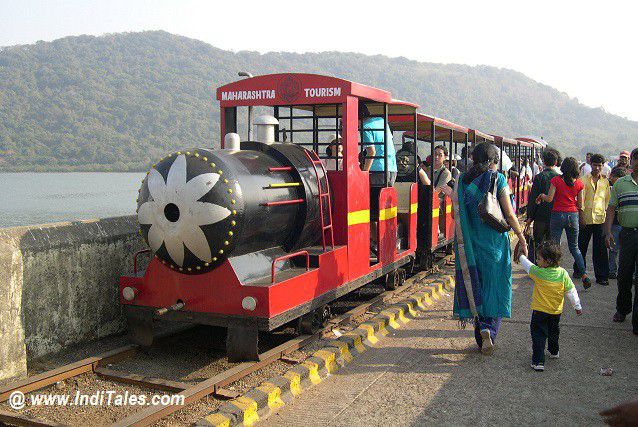
There are seven sculptures carved from rocks each describing different tales and events of the Hindu god Shiva and goddess Parvati. Together they show us the forms of Shiva at Elephanta Caves.
Elephanta Caves

The date of excavation of Elephanta caves or Gharapuri meaning ‘city of caves’ is unknown. However, there is a debate amongst archaeologists about its making. Some say it dates back to the 4th CE while others believe it dates back to the 6th CE. Despite the debate, all historians agree it is a ‘superhuman excavation’ – an inspiration.
Viewing it first time myself, I could not agree more. I am no historian but you don’t have to be to see spectacular sculptures, pillars, and Shrine.
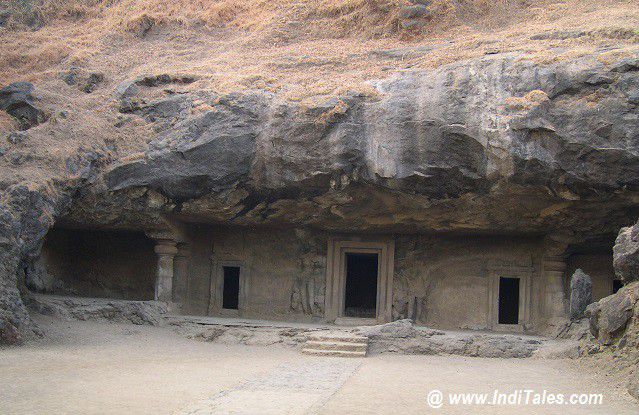
There are seven caves cut from one rock, just one survived the destruction. While viewing and clicking from different angles I had to remind myself that it was carved from rock, not built. You can not but admire the genius engineering and hands that created it. These caves were the worship place for the Hindus where once chanting, prayers and offerings took place regularly. Today the place lies as a tourist spot and prayers are done only during ‘Maha Shivratri’ as permitted by the government.
Destruction of Elephanta Caves
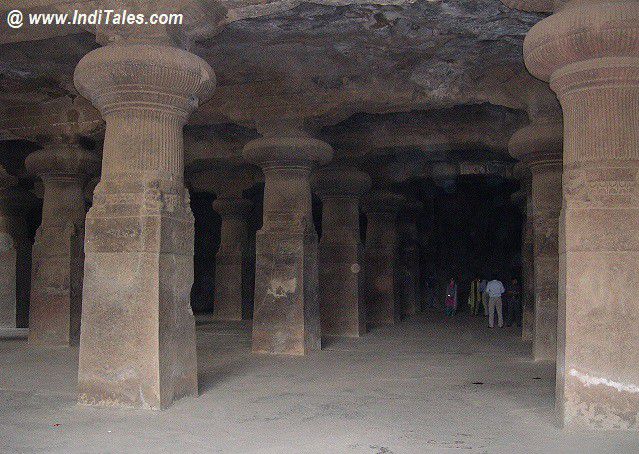
There are versions regarding the destruction, some say it was due to waterlogging and rain. Some blame the Portuguese who wanted to reduce the Hindu influence during their rule. Soldiers practiced targets in the caves sparing nothing but Trimurti, even removing inscriptions of the creation and making of caves. The reason ‘Trimurti’ remained unharmed. Some say it is because of the sense of peace it brought to the viewers. It probably intimidated them too much.
These are all speculations and talks on where why and how that no longer matter. What matters is no further damage happens to them and tourists’ appreciation of what could have been if it stayed untouched.
Shiva as Nataraja

You either go clockwise or anti-clockwise but as soon as I saw this figure I automatically moved toward it without thinking of the flow. Didn’t need a second guess to know it was ‘Nataraja’ the most famous form of Shiva. Natraj comes from a Sanskrit word that translates to ‘Lord of Dancers’ or ‘King of Actors’. Having been worshipping the ‘Lord of Dance’ for nearly a decade both before and after Bharat Natyam I know the significance it holds in the world of performing arts in India.
This dance of his is known as ‘Tandava’ categorized into from forms ‘Ananda Tandava’ and ‘Rudra Tandava’. Ananda depicts dancing for enjoyment while Rudra is violent, vigorous, and considered to be the end of the world.
The lower part of this statue is completely destroyed and only one of the four hands has sustained. The upper right holding Agni (fire), apart from those deities carved around Shiva to spectate his Tandava has also suffered vandalism. Lord Brahma is noticeable due to his three heads on the top right.
What each hand depicts:
- Upper right hand: Damaru (musical instrument) symbolizing rhythm and time
- Upper left hand: holds Agni (fire) symbolizing creation and destruction
- Lower right hand: Abhaya Hasta, where Cobra is coiled on his hand. Symbolizing protection from fear. Cobra symbolizing fearlessness
- Lower left hand: Points downward toward the demon Apasmara on which he dances
Read More – Nataraja – Understanding the Chola Bronzes
Shiva slaying Andhaka

Here Shiva is seen in ‘Bhairava Avatar, translating ‘Frightful’ from Sanskrit. Wearing a crescent and cobra to the high right and a necklace around his neck, he seems to be marching in fury. This sculpture has undergone destruction. Two of four hands and the lower half no longer exist. Yet, the rage in his expression is evident with raised eyebrows swollen eyes, and tusk. You admire the artists who could carve it in stone.
The Lord holds the sword in his right hand, carrying Andhaka’s body after slaying him in the left whose structure is broken. He carries a bowl with his other left hand to collect the dripping blood with the cobra coiled up around his hand.
Shiv-Parvati on Kailash at Elephanta Caves

Shiv-Parvati, seated on Mount Kailash is playing the game of dice. Shiva wears the crown, a ‘Janeu’ or the sacred thread that goes from left to right and is dressed up to his knee. Parvati is dressed in fine accessories with her hair falling in front. Upset with the Lord, she looks away as she lost the game of ‘Chopat’ (dice) only to discover Shiva has been cheating. Right behind her, between her and the Lord is a woman holding a child identified as ‘Kartikeya’ her son. At Shiva’s feet skeleton of Bhringi is seen (he vowed to worship only Shiva for the rest of his life.) Unfortunately, this sculpture has undergone massive destruction, nothing much of anything remains, it was traced by similar sculptures found in Ellora caves.

Another panel depicts the wedding of Shiva and Parvati. See the coy expression of Parvati that is still so visible despite all the destruction of the panel.
Ravana lifting Kailash Sculpture

This sculpture has Shiva with Parvati by his side residing on Kailash, surrounded by other deities in the upper half. The Skeleton of Bhringi is seen near Shiva’s feet while in the corner right is ‘Ganesh’ – Shiva’s son. In the bottom half of the panel, below Shiva is Ravana, (sadly the carving and traces to that have been destroyed) trying to lift Kailash Parvat.
The legend goes like this – once impressed by Ravana’s prayers Shiva grants him the wish. Ravana asks to be powerful, and despite other deities as seen in the cravings protesting to not do so, the Lord granted him the wish. In order to test his might Ravana shakes up the mountain where Vishnu is seen riding Garuda on the top left, Shiva’s family and numerous other deities are around them. Lord simply moves his toe and the mountain stops shaking. Pressure starts to crush and suffocate Ravana from the weight. He learned the lesson that he might be powerful but he can not even combat Shiva’s toe. Understanding what he did, he starts to sing songs praising the Lord after which the Lord forgives him and lets him go.
Read More – Ramayana Places in Sri Lanka
Yogishvara

Receding on the Himalayas, Shiva is seen sitting in padmasana – the lotus pose of yoga. Hence he is called Yogisvara or Mahayogi. His eyes are closed and distant – deep into the meditation after the death and loss of his first wife Sati. He is said to be seated on a lotus carried by ‘Nagas’ or snakes. Surrounding him are the divinities in the sky and attendants below.
Sati killed herself as her father disrespected her and didn’t honor her husband ‘Shiva’ who is the god himself. Ashamed of her father’s act she remembered her husband and prayed to Aadishakti to burn Sati’s body, to be reborn to the father who she could respect. She was later born Parvati, who Shiva later remarries.
Shiva lost his cool after Sati dies. He performed ‘Tandava’ with Sati’s charred body on his shoulder. It is known that Shiva’s ‘Rudra Tandava’ would lead the world to destruction. Vishnu had to intervene by cutting Sati’s body into pieces with his Chakra.
In the sculpture, both hands and legs suffer destruction.
Other deities include Brahma, riding swan, Indra without ‘Airavat’ his elephant, Vishnu riding Garuda on a plantain leaf, and the Sun-god or Surya riding a fully saddled horse (head missing). Then, there is a saint with a rosary, two female figures in the sky draped up to their thighs, and a faceless figure of the moon with a water container. There are three identical figures of a male flanked by two females; the skeleton of a sage who came to calm Shiva suffer destruction too.
Gangadhara

To the right of the tri-murti is another beautiful sculpture broken into pieces telling a tale clearly it’s supposed to – the story of the holy river Ganga descending to earth from Shiva’s matted hair. This sculpture can be seen in many places across India. What makes these caves interesting is the three-headed female representing Ganga, Yamuna, and Saraswati.
Ardhanarishvara at Elephanta Caves

Left to Tri-murti is probably the best sculpture except the masterpiece signifying men and women as equal, one, whose existence remains insignificant without the other. ‘Ardhanarishvara’ quite literally means half man half woman, split from down the middle.
Ardhanarishvara sculpture is broken from below the legs. Shiva is on the right, (left to the viewer) whose one hand is on Nandi. Parvati forms the left (right to the viewer) in a delicate pose. Details of both Shiva-Parvati are rendered in respective halves. Growing up in a Hindu family I heard this story over the years where neither Brahma nor Vishnu ever fully passed their knowledge to their wives. For the Lord, his wife is no less than him, and he is no more than her.
There are other versions to this as well, one of which says Bhringi took an oath to worship Him solely, ignoring Parvati sitting beside him. She asked Bhringi to worship her too but he refused. Agitated she asked Shiva to give her half part of his body and the Lord agreed to merge both of them into one.
Trimurti at Elephanta Caves

Considered a ‘masterpiece of Gupta-Chalukyan art’ this is the most important & most impressive sculpture in the cave. The vastness of this figure is intimidating. There is an amount of calmness and serenity I experienced. It’s the only sculpture that has not suffered much in terms of destruction.
Aspects of Shiva
Based on six principles of the universe according to Hinduism, this sculpture shows three of six aspects of the Lord.
- The left face (viewer’s right) represents the feminine side, holding a lotus, there is a light smile carved on his face that cannot go unnoticed, it shows his caring nature to every being, called ‘Vamadeva‘ resembling Brahma.
- The right face (viewer left) has a mustache and is holding a snake in his hand, depicting him filled in rage. It is believed that his anger can burn the world into flames with his third eye. This form of his is known as ‘Rudra‘
- Central face instantly soothes you into it at first gaze, engrossed in meditation is enlightened, a yogi and engrossed in his thoughts to the betterment of the universe, this aspect of his is called ‘Tatpurusha‘ resembling Vishnu this also earns him the name ‘Yogeshwar‘
Read More – Rudra Shiva of Tala
More
The other three aspects are not carved but are said to be at the back, they are as follows:
- Isana internal aspect that conceals; associated with all that exists; represents ether (space).
- Aghora south-aspect that rejuvenates manifest Brahman; associated with Rudra; represents fire.
- Thiruvadhanam’s six-faced Kartikeya was created by the Lord using his third eye of all the above six faces.

I came out of the caves in awe of these forms of Shiva.
If you are wondering where is the Elephant that gives these caves their name, read this – Elephanta’s Elephant at Bhau Daji Lad Museum.

——————————————————————————————————








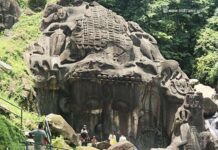
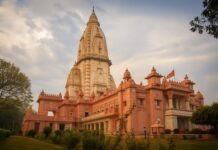





Nice historical information about Lord Shiva and caves
Thanks, Vasant. Glad you enjoyed the post on Elephanta Caves.
Thank you 🙂
I did visit this place, but only explored about three headed Shiva… Where did you get all the details from? A nice collection. Nicely captured the Elephanta.
All these sculptures are right there surrounding the Trimurti. Visit it once again and look more intently on the walls around, you will find all these forms of Shiva in all their splendor.
Abu, thank you. These sculptures are all around TriMurti
Thanks for sharing us.
Welcome.
दो बार गेट वे आफ इण्डिया से आगे जाने के लिए बोट नहीं मिल पायी, देखते है कब यहाँ जाना हो पायेगा।
संदीप जी – वर्षा ऋतू के बाद जाइए – अधिक आनंद आएगा
Absolutely fabulous pictures .
Thank you, Jessy.
Jessy: Thank you
Gr8 information Ma’am .
I have watched so many videos about elephanta caves but none of them shows these highly influential pictures of lord Shiva .it’s a gr8 piece of information .
Thanks for providing it ????
Thank you, Himanshu. Glad IndiTales could help you understand sculptures at Elephanta Caves.
Thank you Himanshu for the words of appreciation
Very well written article. Keep up the good work team! 🙂
Thank you, Akshay. Stay connected for more travel blogs at IndiTales.
Thank you so much for Great historical information on Elephanta Caves, But you forget “Shiva Linga”….. I hope you will add ASAP.
wow excellent pictures clarity
Explore Elephanta Cave in 3D.
Beautiful rendition of the Elephanta, Panel by Panel along with relevant Photographs. God bless you. Om Namah Shivaya.
Namah Shivay Marali Ji. Thank you for your encouragement.
Elephanta and Ellora caves both are the part of Unesco heritage sites.It has great architecture related with Hindu god.This blog is full of information very well described.
I am a great admirer of Lord Shiva and so I always keep reading about the temples and caves. During my online research, I landed over this blog. It is so well written. The Elephanta caves in Mumbai have so many forms of Lord Shiva. I am really impressed and want to visit the caves again.
Monolithic basalt sculpture of an Elephant found near the entrance made Portuguese name it as Elefante.
They tried to rob that Sculpture but failed.
It is now placed at the Jijamata Udayan in Mumbai
I think it is at Bhau Dai Lad Museum in Mumbai now.
I absolutely loved this post! The intricate details about the different forms of Shiva at the Elephanta Caves and the stories behind them are fascinating. It’s amazing how much history and artistry is captured in those sculptures. Your insights made me want to visit these caves and experience the spirituality and culture firsthand. Thank you for sharing such an enriching perspective!
What a fascinating exploration of the Elephanta Caves! The intricate carvings and the stories behind each form of Shiva really bring the history to life. I loved learning about the symbolism and cultural significance of these masterpieces. Thank you for sharing such detailed insights!
This is such a captivating exploration of the Elephanta Caves! The intricate carvings and the stories behind each form of Shiva really bring the history to life. I loved learning about the symbolism and significance of each representation. Thank you for shedding light on this incredible cultural heritage!
What an insightful post! I loved learning about the different forms of Shiva at Elephanta Caves and the captivating stories behind each sculpture. Your descriptions really brought the history and significance of the site to life. Thank you for sharing such rich cultural insights!